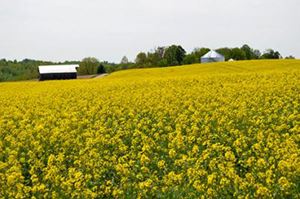|
Interest In Canola Increasing In Kentucky

A canola field bursts with color in Austin.
PHOTO: Katie Pratt, UK Agricultural Communications
AUSTIN, KY.
With the state’s first canola crushing facility coming online this past December, interest in canola is running high among farmers, and some Kentucky fields are starting to get a splash of yellow during the spring. A specialist with the University of Kentucky College of Agriculture, Food and Environment is working with farmers and consultants to make sure Kentucky farmers ramp up production in a way that’s agronomical and economically beneficial for them.
“Canola is a really good option for a producer to diversify their operation in terms of economics, and there are some known agronomic benefits to growing canola,” said Carrie Knott, UK grain crops extension specialist. “Several years ago, research in Kentucky showed yields of double crop soybeans increase when they follow canola compared to following wheat.”
Knott is working with area farmers and Brian Caldbeck, a consultant agronomist with Caldbeck Consulting, on this new crop opportunity. The Hart AgStrong canola crushing facility in Trenton plans to eventually receive between 35,000 and 70,000 acres of canola when it reaches full capacity. In its first year, it has contracts for 24,000 acres. Kentucky farmers account for between 10,000 and 11,000 of that acreage.
Caldbeck has worked on winter canola research since 2004, when he was working at Miles Farm Supply in Owensboro. There he found a variety that yielded well, and farmers could successfully follow it with double crop soybeans. Since then, he’s been helping interested farmers expand into canola production. This includes establishing Rubisco Seeds, a Kentucky-based hybrid canola seed company with his wife Claire.
One farmer he has worked with is Terry Warkentin, who runs a diversified operation in the Austin community of Barren County. Warkentin had basic knowledge of the crop from watching his father produce it while he was growing up in Manitoba, Canada, a major canola production area. He is excited about the higher yield potential Kentucky has compared to Canada and the ability to sell his crop locally to the crushing facility.
Having previous knowledge of growing canola like Warkentin has is rare among Kentucky grain farmers, who usually have crop rotations of corn, soybeans and wheat. Knott and Caldbeck said it’s important for interested producers to do their homework before jumping into canola production. Canola requires more management than winter wheat. It is planted and harvested earlier than winter wheat, and once a field is used to grow canola, producers can’t grow it in the same field for three or four years.
Due to its small seed size, canola is typically planted using conventional tillage methods. Warkentin is one of the few farmers in the state who have been able to adapt the crop to a complete no-till system. Knott is beginning research on how more farmers can adapt canola to their no-till or minimal tillage system.
“It has such a small seed that it gets placed much better in a conventional tillage system, she said. “That’s how it’s planted throughout much of the country, but since Kentucky is a no-till state, I’m working very hard to see how we can use science to make growing no-till canola a possibility for more of the state’s producers.” ∆
|
|